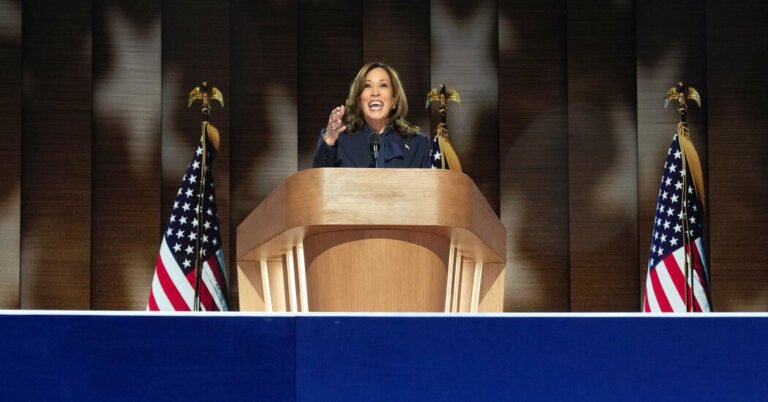
It was perhaps the biggest speech of Kamala Harris’s life, the first time a Black or South Asian American woman would accept the Democratic nomination for president.
She had come to the stage at the United Center on Chicago’s West Side with an opportunity to share her story and vision with millions of Americans.
The crowd roared as the vice president’s entrance song, Beyoncé’s forceful “Freedom,” coursed through the building.
Ms. Harris, eschewing suffragette white in favor of a dark suit, beamed as she took in the scene: cheering delegates waving long blue signs bearing her name.
In the first row below the rostrum, Ms. Harris’s excited great-nieces Amara, 8, and Leela, 6, held up handmade signs.
As Ms. Harris began her speech, Amara peered up at the vice president. In a small buffer zone behind the girl, a photographer for The New York Times took a picture that captured the power of the moment. It quickly went viral.
Todd Heisler was one of just a handful of photographers in the buffer zone, a crowded and contained area that was directly in front of the California delegation. He had good fortune, he said: No TV cameras were blocking his view.
Crouching down, he maneuvered his way a few feet behind Amara and shot the photograph while kneeling.
“It’s a very frenetic situation,” he explained, adding, “If you can get one picture that will resonate with people, you’re very lucky.”
Framed onstage by American flags, Ms. Harris struck patriotic and bipartisan tones throughout her nearly 40-minute speech, continuing a weeklong theme for a Democratic Party intent on selling itself as the party of patriotism.
Ms. Harris, who has only 10 weeks to fully introduce herself to the American public before the election, also shared how her mother had traveled at age 19 from India to California, dreaming of becoming an American scientist.
She spoke of how her father, a student from Jamaica, had come to the United States. How he had fallen in love with an Indian American dreamer. How they had raised her and her sister to dream big dreams, too.
“Don’t be afraid,” her father had told her. “Don’t let anything stop you.”
She recalled how her neighbors in the San Francisco Bay Area helped raise her, and became her family by all but blood.
She also spoke of challenges — how her parents had split up, and how her mother worked long hours to make ends meet.
Ms. Harris’s rise to become the face of the Democratic Party has been at once slow and sudden. She spent the better part of two decades in prominent law enforcement offices in California. She served in the U.S. Senate and, in 2020, ran for president.
But before President Biden ended his re-election campaign on July 21 and the Democratic Party united behind Ms. Harris to be his successor, she had never been so squarely in the spotlight.
Her campaign now carries the weight of history. No woman has served as the country’s president. She is the second Black presidential nominee from a major party, and the first South Asian American nominee.
Ms. Harris nodded toward those facets of her identity, but did not dwell on them. She said she was running for every American, without “regard for party, race, gender.”
The words “first ever” did not leave her mouth.
Still, she said she had seen how people could sometimes treat her mother, who was a “brilliant five-foot-tall brown woman with an accent.”
When the time came to formally accept the nomination, she said she was doing so on behalf of the American people, her mother and “everyone who has ever set out on their own unlikely journey.”
As Ms. Harris turned her focus to the road ahead, her great-nieces sat in the front row, listening intently.
Ms. Harris vowed the United States would not return to the era of her opponent, Donald J. Trump. “We are not going back,” she said six times.
“We are charting a new way forward,” she said. She added, “This is personal for me.”